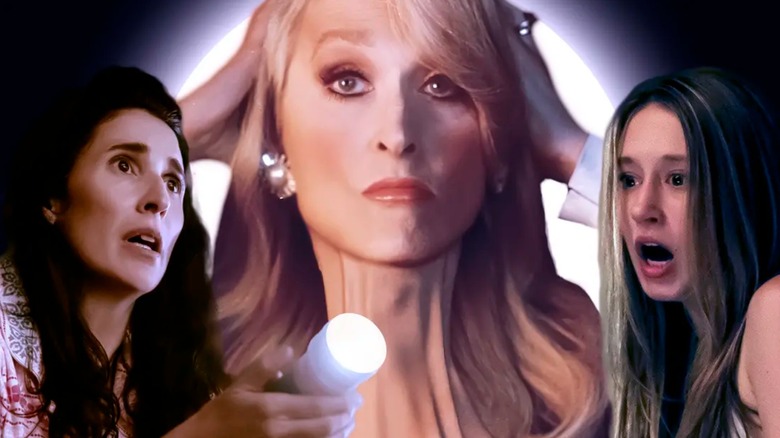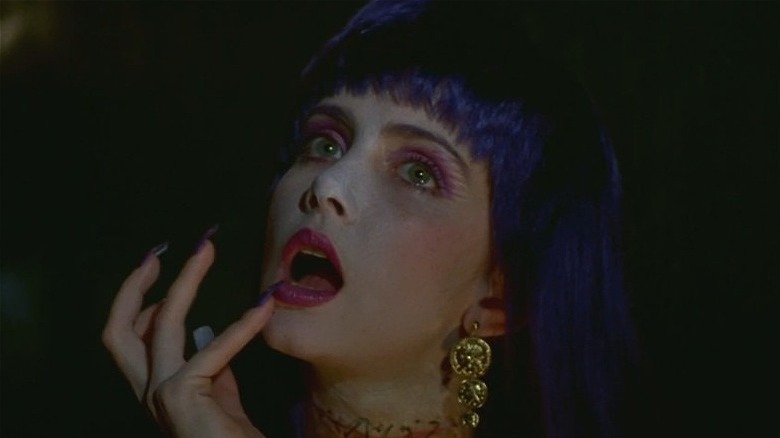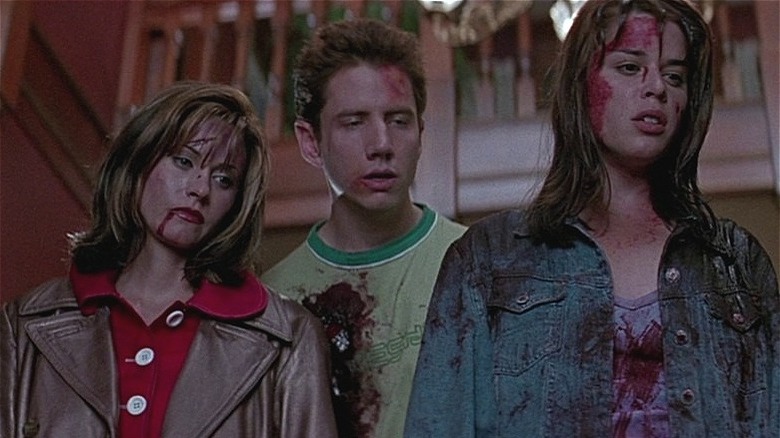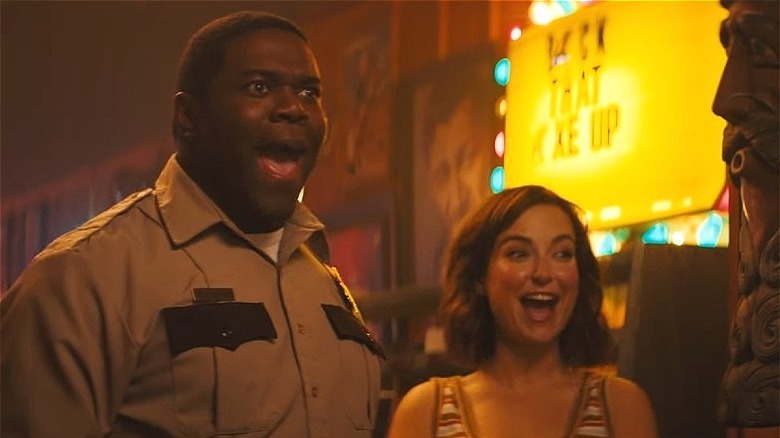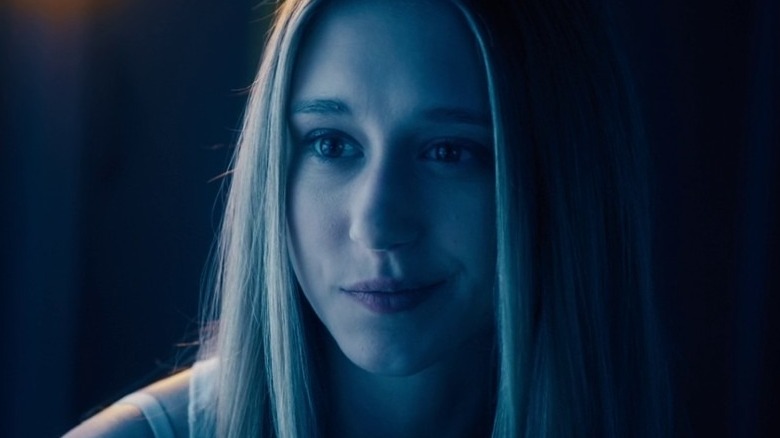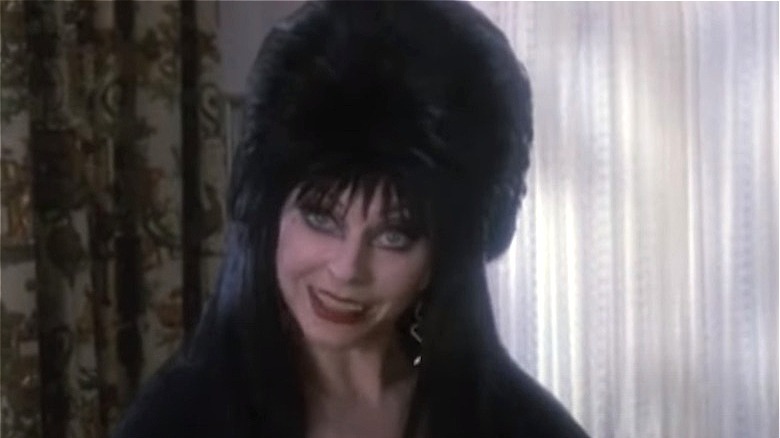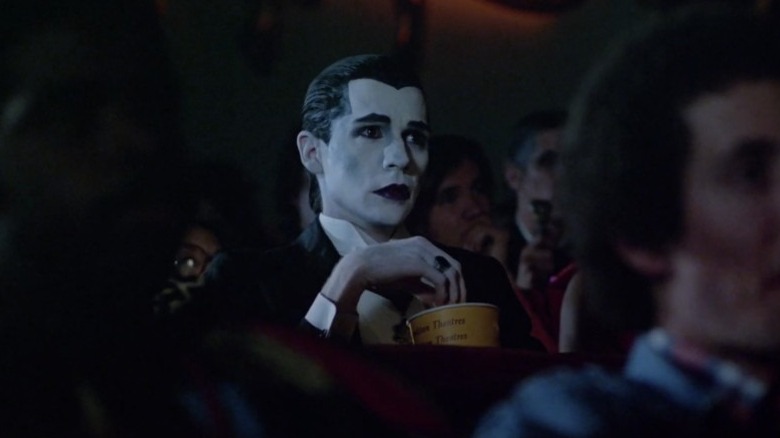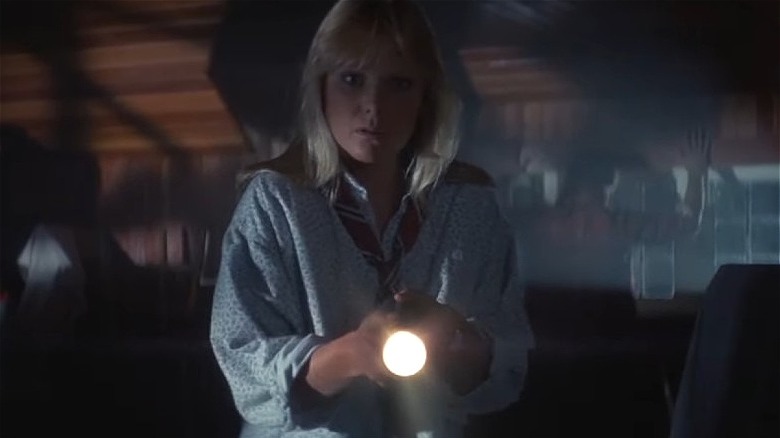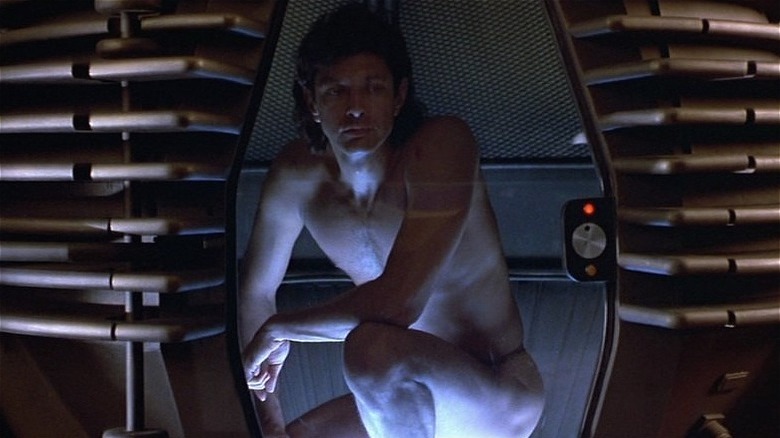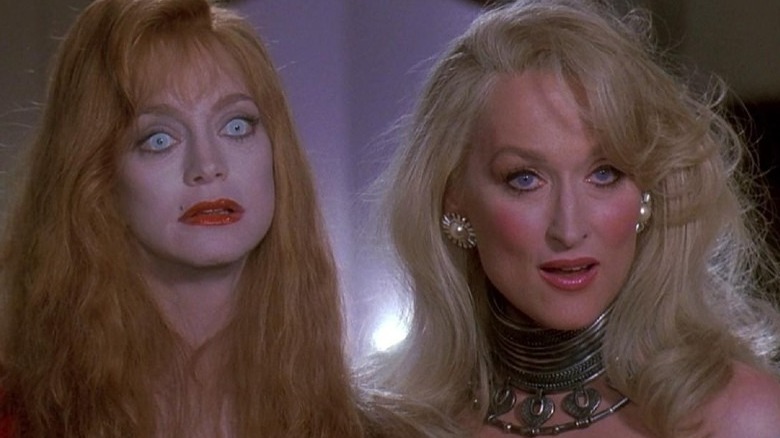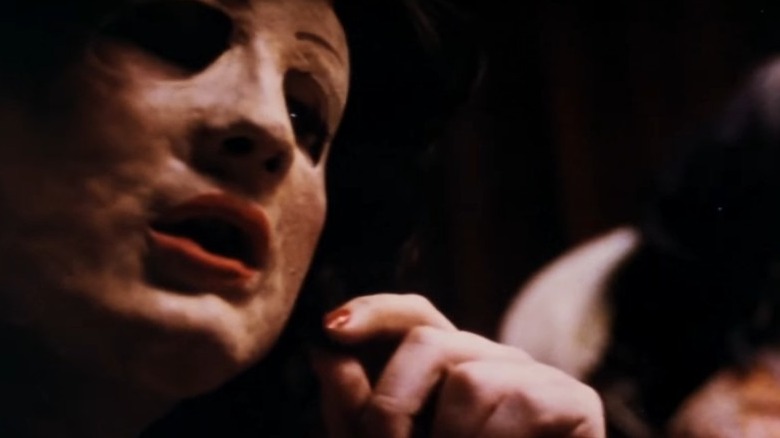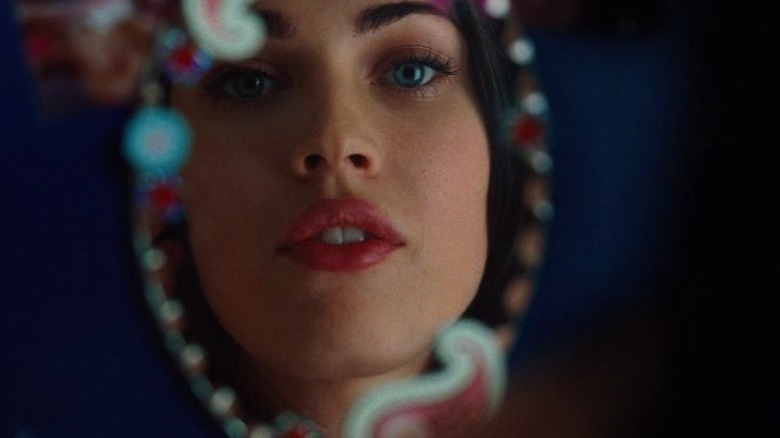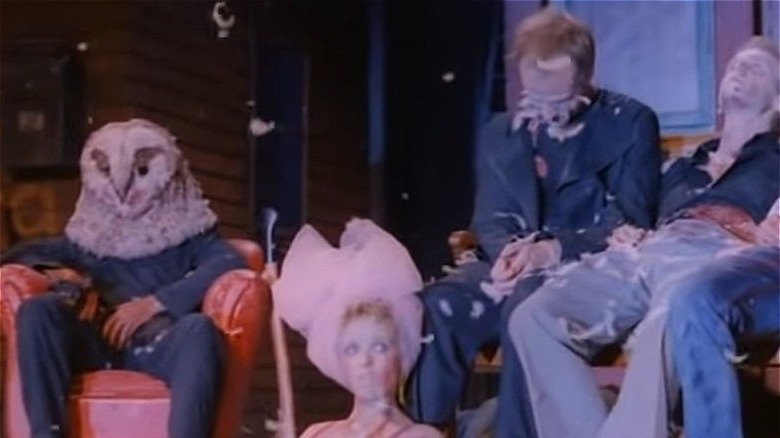12 Horror Movies That Would Make Great Musicals
Believe it or not, horror-based musicals are a rarity. Sure, there's "Frankenstein – A New Musical," "Little Shop of Horrors," "The Rocky Horror Picture Show," and "Dracula, the Musical," among a few others. But in the scope of musical theater history, those are mere blips on the radar. Considering original horror movies have raked in hundreds of millions of dollars over the last year alone, horror musicals should be a no-brainer. There is a treasure trove of stories that could easily make the transition from film to the stage. Of course, you'd have to make a few tweaks in the storytelling here and there, pare down the locations to a handful, and hire a strong practical makeup effects department. Let's face it, these days, you've gotta have the blood!
Flipping through the decades, '80s and '90s horror has an inherent theatricality to it, owed largely to Gialli and slasher influence. Naturally, those eras would be easiest to adapt into musicals, while giving you plenty of license to expand on the story and add songs, even for the killers. Whether we're talking about a good old-fashioned slasher, a slap-happy whodunnit, or a dark thriller about obsession, horror movies are a gold mine for potential musical iterations. If you don't believe us, we'll show you. Below, we've selected 12 horror films that would make terrific musical adaptations for the stage.
Frankenhooker
No one ever expected Mary Shelley's "Frankenstein" to get such an outrageous treatment. Writer/director Frank Henenlotter flips tired cliches and taps into something far weirder. A real camp treat, "Frankenhooker" stars Penthouse pin-up Patty Mullen as Elizabeth, a sex worker turned Frankenstein-plaything. When Elizabeth is unceremoniously dispatched by a remote-controlled lawn mower, her grieving boyfriend Jeffrey makes it his mission to reconstruct his lady by exploding sex workers and sewing body parts together to create a new and improved Elizabeth. It's as wild as it sounds.
In the right hands, one could bring a "Rocky Horror Picture Show" absurdity and musical panache to the stage. Imagine Elizabeth ripping into a provocative "Sweet Transvestite"-rendered tongue-slider, or even a "Touch-A, Touch-A, Touch-Me" shimmy. "Wanna date?" would make a great musical number, dontcha think? Or maybe Jeffrey, as he stitches together legs and torsos, reworks "I Can Make You a Man" into a gender-flipped crescendo.
As outlandish as the story is, "Frankenhooker" also has something to say about womanhood and identity. These themes could be woven into the musical fabric, allowing the characters to have big, emotional moments. Elizabeth and Jeffrey are the obvious linchpins, but the sex workers and their hot-headed pimp with oversized muscles would need ample screen time to delve into songs about the sleazy underbelly of sex work and the exploitation of women's bodies. There's so much potential to mine, it's rather surprising a production hasn't been mounted, even on the off-off-Broadway scene. It's an absolute gold mine.
Scream
Writer Kevin Williamson has gone on record to say that "Scream" is "coded in gay survival," and there's no better medium to further explore this idea than in a musical setting. With Sidney the prime target, Ghostface has always presented a theatrical flair, from the long black robe to the way he wipes blood from his blade. Not only does the 1996 film have a "Phantom of the Opera" frill, but the deaths are elaborate and melodramatic (Casey Becker's opening kill springs to mind).
There are the obvious musical moments for Sidney — a contemplative ballad as she remembers her mother and a "Not in My Movie" show-stopping closer — plus, Gale and Dewey getting at least one big solo performance. In all its gory glory, "Scream: The Musical" takes cues from that "Once More ... with Feeling" episode from "Buffy the Vampire Slayer." Perhaps even the characters wonder why they're breaking out into song in the first place, with them trading killer suspicions in an "I've Got a Theory"-inspired patter song and an emotional send-up drawn from "Walk Through the Fire," as Sidney contemplates her role in saving the day. And envision Tatum and Stu breaking out into a performance reminiscent of "I'll Never Tell" and Billy waxing bad-boy angsty with a "Rest in Peace" turn 一 nothing short of epic!
In the end, a musical adaptation embellishes what is already present in the script, from its inherent queerness to the serrated empowerment edge. It just needs a little musical magic.
Werewolves Within
Based on a video game from Red Storm Entertainment, Josh Ruben's "Werewolves Within" boasts an eclectic band of characters, in an "Into the Woods" sort of fashion. Centered around Beaverfield, Sam Richardson's Finn Wheeler, a forest ranger, is tasked with overlooking the small town as its residents battle over a proposed pipeline. In a 15-minute musical prologue, we learn more about the characters, their dynamics, and their dreams and desires.
In the snow-capped town, a werewolf lurks in the surrounding woods, unbeknownst to the townsfolk. When a body, torn to shreds, shows up, Dr. Jane Ellis suspects an animal caused such savagery. Through the web-spun tale, the residents must figure out who could possibly be behind the murders. Character-driven numbers include "Finn's Lament" (in the vein of "Giants in the Sky"), Cecily and Finn aching for one another (think: "Agony"), and an "I Know Things Now" performance delivered by lodge proprietor Jeanine Sherman. With the werewolf reveal, Cecily launches into a smoldering "Hello, Little Girl" performance, snarling and baring her teeth.
A wealth of musical potential lies within "Werewolves Within," a story that could easily be chopped into two acts. Ellis' revelation that the monster is, in fact, a werewolf would make an apt first-act closing number, a perfect time for a deliciously dark and mystical "The Witch's Transformation" interlude. Wound up with mystery, "Werewolves Within" makes for a musical epic with a perfect balance between emotional urgency and humor.
The Final Girls
With its pulsing emotional core, Todd Strauss-Schulson's "The Final Girls" is quite similar to "Anna and the Apocalypse," a holiday-themed zombie musical. Max and Anna, the heroines of the respective films, learn to deal with their grief through extreme circumstances. In "The Final Girls," Max is sucked into the cult classic "Camp Bloodbath," in which her late mother played the part of counselor Nancy. Still reeling from her mother's death, Max rips into a "Break Away"-type song, finding herself longing to break free from her pain and leave the world she knows behind.
Along with her friends Gertie, Duncan, and Chis, Max must figure out how to escape their slasher purgatory, all the while evading the sharp blade of serial killer Billy Murphy. "Hollywood Ending" makes for a great template for the opening number, introducing the film-within-a-film cast. Another counselor, the very horny Kurt, steps into a reworking of "The Fish Wrap" — I mean, the sexual innuendos practically write themselves. "Turning My Life Around" would give Max that pivotal character moment when she finally conquers her grief, with "Human Voice" setting up the very ending in which the characters quickly realize they are now in the "Camp Bloodbath" sequel.
For all its campiness, "The Final Girls" emotionally pulverizes the viewer, particularly in its use of Kim Carnes' classic hit "Bette Davis Eyes." Through a sweeping pop/rock approach, there are plenty of chances to tap into heavy themes about death and grieving in song form.
Elvira, Mistress of the Dark
Out of all entries on this list, it's most surprising there hasn't been a "Elvira, Mistress of the Dark" musical. Considering that Cassandra Peterson once fronted such bands as I Latins 80s, toured with Mamma's Boys, and performed in "Vive Les Girls" in Las Vegas, there's so much untapped potential to stage a glam-rock spectacle. "Hedwig and the Angry Inch" makes for a great jumping-off point to razzle 'n dazzle with Elvira's own quirky, hyper-stylized twists — with some "Hair" tossed in for good measure.
When arriving in the staunchly conservative Fallwell, Massachusetts, Elvira borrows a cue from "Tear Me Down" (from "Hedwig") for an opening epic. "You can try to tear her down" rings like an alarm, a defiant creed in the face of a world that frequently underestimates her. The entire story — claiming an inheritance from her great aunt — drives the plot and many of its musical numbers. From the rumble of such "Hedwig" songs like "Sugar Daddy" and "Angry Inch," the stylistic sensibility aims for big choruses, glitzy costumes, and sexual energy.
Thematically, "Elvira, Mistress of the Dark" satisfies the arc from misunderstood outcast to triumphant queen landing her dream show in Las Vegas. Despite the world telling her no and constantly judging her appearance, Elvira perseveres and is able to finally express the deepest desires of her heart through song. She could have easily packed her bags and left town, but she makes it clear she's never going anywhere. Perfect musical material.
Fade to Black
"Sweeney Todd: The Demon Barber of Fleet Street" sets the dark and macabre atmosphere from the outset, its dark and moody "Prelude: The Ballad of Sweeney Todd" twisting the musical screws. The 1980 horror/comedy "Fade to Black" carries a similar tone and supplies a strong, warped backbone apt to be fleshed out for the stage. Its deliciousness comes from Eric Binford, a terribly awkward, smug, and film-obsessed young man who goes on a murder spree dressed up as his favorite icons.
Each costume reveal, from Dracula to Hopalong Cassidy and The Mummy, is ripe for a grand musical number. "The Barber and His Wife," "Pirelli's Miracle Elixir," and "The Worst Pies in London," among other songs, give Eric room to play and showcase real vocal prowess. Each murder committed fuels Eric's slow descent into madness, his grip on reality loosening, as he launches into songs akin to "Epiphany." He hides away in his delusions as a way to not only escape his life but fulfill a deep, unexplainable yearning inside of him.
Eric soon reaches a point of no return and climbs high atop Mann's Chinese Theatre, soundtracked with a "Final Sequence"-type song. He reenacts a scene from "White Heat" but is shot by the police and tumbles to his death onto the ground below. With a brooding closer titled "The Ballad of Eric Binford," the show tangles together its themes of entitlement, obsession, and mental health into a wonderfully knotty knot.
April Fool's Day
Murder mysteries always make for great musicals. This 1986 Fred Walton film presents itself as a slasher, with a mysterious killer picking off the characters one by one. Set on a secluded island, the one location is easily adaptable to the stage, which requires very few separate locations to tell its story. In the vein of "Something's Afoot," "April Fool's Day" is a delightful romp and features quite a cast of characters, including aloof party host Muffy, cigar-puffing Harvey, and final girl Kit. While riffing on genre tropes, it also flips expectation on its head.
"Something's Afoot" and "Suspicious," in which the characters consider the many clues, serve as the core songs for the show. Other entries — "The Man with the Ginger Mustache" and "Dinghy," for example — bring some levity to otherwise grim circumstances. As each character is bumped off, their deaths possessing a particular theatrical gleam, the musical numbers build and build into the finale. When all is finally revealed (no spoilers!), the last two characters standing launch into a spirited "I Owe It All"-inspired dance number, leading into the "New Day" closer.
With a delightful humorous edge, "April Fool's Day" is packed full of suspense, mystery, and murder. The vaudeville-spun musical numbers are just an added bonus. It might be little more than fluff entertainment, but it sure is a hoot unraveling the truth.
The Fly
In 2008, an opera loosely based on the 1986 David Cronenberg film premiered in Paris before making its way to L.A. The music was composed by Howard Shore and the libretto written by David Henry Hwang. It was met with rave reviews, as the Los Angeles Times called it a "monster smash." Surprisingly, "The Fly" has yet to see a proper musical adaptation. Fashioned like "Little Shop of Horrors," a fresh iteration could lean into the absurdity of the story through glossy pop hooks and flashy set design.
On the cusp of a major scientific breakthrough, Seth Brundle bemoans his work in creating his teleportation devices a la "Skid Row (Downtown)" and "Grow for Me." All the while, Veronica Quaife struggles as a journalist in finding her next big news story. Much like Seymour and Audrey in "Little Shop," the two strike up a fevered romance, trading off verses in a "Suddenly, Seymour"-pinned musical number. When Seth mistakenly teleports with a fly, their DNA become intertwined, and soon he devolves into a fly-human hybrid.
With the story growing darker, so does the music, veering into "Suppertime" territory. And even Stathis gets a moment in the spotlight with a tune akin to "Dentist!," as the scorned, obsessive ex-lover. I'd like to think "The Fly" and "Little Shop of Horrors" live within the same sci-fi universe. Both involve outlandish premises that easily lend to bold and loud musicals. It's long overdue we get "The Fly: The Musical" primed for the stage.
Death Becomes Her
In 2017, a musical was announced with Kristin Chenoweth set to star as Madeline (performed by Meryl Streep in the 1992 original black comedy). But there hasn't been any news or updates since then. Maybe now is the time. Taking musical cues from "Dirty Rotten Scoundrels," namely "Give Them What They Want," a "Death Becomes Her" musical goes big on the glamor. The Robert Zemeckis-directed film has all the campy glory you could possibly want for the stage.
The story follows Madeline Ashton, a Broadway performer who steals Ernest from frenemy Helen Sharp. Helen wails to "What Was a Woman to Do," soundtracking the passage of time as Helen succumbs to a dark depression. Years later, Helen exacts her revenge by drinking a potion that gives her eternal life and beauty. Helen then seduces Ernest to convince him to kill Madeline, who has also consumed the life-giving potion. During an argument, Madeline tumbles down the stairs and breaks her neck. She quickly learns her body can still be mutilated, requiring surgical touch-ups.
Throughout the rest of the musical, Helen and Madeline vie for Ernest's affections through a "The More We Dance" tango number and the "Like Zis/Like Zat" schmoozer. When it becomes clear they will need to keep Ernest around, they attempt to get him to drink the potion, but he refuses. The soundtrack — including songs inspired by "The Reckoning" and the "Finale" — are as glitzy as the costumes. The possibilities are endless!
Texas Chainsaw Massacre: The Next Generation
Hear me out: "Texas Chainsaw Massacre: The Next Generation: The Musical." The 1995 Kim Henkel picture is the most outrageous of the franchise and features a gender-bending Leatherface and an unhinged performance from Matthew McConaughey as Vilmer. The cast, also including Renée Zellweger as high school student Jenny, supplies plenty of camp goodness to make a perfect musical adaptation.
From its rock underpinnings and just hilarious conceit, "Bat Boy: The Musical" is a key touchstone for a Leatherface-based musical. "Hold Me, Leatherface" (a rip-off of show opener "Hold Me, Bat Boy") sets both the tone and humor for the show, with heavy rock guitars paired with strong '80s-style vocals. The family unit — comprised of Vilmer, Darla, and Walter — leads the cast of characters, rounded out with other teens like Barry and Heather. Influenced by numbers "A Joyful Noise" and "Apology to a Cow," Leatherface steps into the spotlight with songs of his very own, perhaps "Apology to a Corpse" instead.
The show, containing "A Joyful Noise" and "Comfort and Joy"-inspired songs, follows much of the film's story. Teens get lost and get killed off. Only Jenny survives, ending up in a limousine with a member of a secret society, which plotted to terrorize the public as a vehicle to transcend beyond the physical world. With songs also influenced by Elvis Costello, "Texas Chainsaw Massacre: The Next Generation: The Musical" is, if anything, lighthearted fare guaranteed to make you laugh at its zaniness.
Jennifer's Body
Imagine this: a "Jennifer's Body" musical in the vein of "Chicago." In lieu of Needy presenting the story through a flash forward, Jennifer leads with an "And All That Jazz" number, complete with sweeping piano accompaniment, in which she celebrates her tantalizing beauty. She's irresistible to boys and unashamed to admit it. Once Jennifer transforms into an insatiable succubus, one of her first kills takes place in the woods surrounding the high school. Jennifer lays it on thick with a seductive and sexy reimagining of "When You're Good to Mama," enticing a jock to make out before ripping his head off.
Jennifer's bloodlust doesn't stop there. When Jennifer inevitably kills Colin, the resident emo kid, "Cell Block Tango" morphs into "Schoolhouse Tango." Needy and her boyfriend Chip, as well as Low Shoulder band members, jump into the song with their own verses. Playing to the audience, they break the fourth wall and simply act as a Greek chorus, in a way. Needless to say, "He had it coming" takes on a frightening and thrilling new meaning. And how could you tell Jennifer she was wrong? Chip would get his own "Mister Cellophane" solo number, while Needy would close out the show with "I Move On," finding her locked inside a mental ward. Directed by Karyn Kusama, "Jennifer's Body" has a proclivity for glam, so it stands to reason a musical adaption would lean into big, bold musical numbers and vibrant stage design.
Stage Fright
The 1987 Michael Soavi slasher features a play-within-a-play. The characters are involved with an upcoming production based on a serial killer known as the Night Owl. When rehearsals don't quite go as planned, director Peter demands the group stay overnight to fine-tune a few things. Over the course of the evening, a real-life serial killer escapes from a mental ward and sets his sights on the troupe of players. One by one, they each meet a grisly end in true slasher fashion.
Given the premise, it makes it pretty easy to adapt this for the stage. Borrowing rock musical theatricality from "Spring Awakening," a "Stage Fright" musical leans into arena-style production and arrangements. Songs like "Mama Who Bore Me" and "The Dark I Know Well" are ideal jumping-off points for its own sort of dazzling book and lyrics. Considering the killer wears an owl head, you could riff off "The Masked Singer" and give them a few numbers of their own — in the style of "Totally F***ed" and "The B**** of Living." Musically, all you really need to add is plenty of sexy saxophone solos and maybe some brass instruments.
"Stage Fright" has a grimy feel to it, as well. Despite it being rather ho-hum when it comes to the deaths, a songbook with a pop-rock sensibility would take it to the next level. Can you imagine an owl-headed killer slaughtering someone while ripping into a ballad? Well, now you won't be able to not to!
